| |
|
St
Joseph, Sheringham
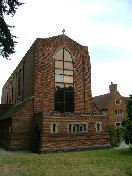 |
|
I
always think that it must be difficult for
English Catholic congregations to step out of
their often small, undistinguished churches, into
the shadow of the huge medieval churches that
were once in their care. A case in point is at
Cromer, a few miles from here, where the medieval
parish church has the tallest tower in East
Anglia. Catholic Priests ministered to the parish
churches of England until the final break with
Rome in 1557, but after that they fell into the
care of the new protestant Church of England, and
celebrations of the Catholic Mass became
punishable by death. How
strange now to think of lost Catholic England! Of
course, many other countries experienced the
Reformation, or religious discords of their own
kind, even wars; but only England sees its past
refracted through the puritan fire of the 17th
century. England is a nation which, for much of
its early modern history, was virulently, even
pathologically, anti-Catholic, a culture in
which, for several centuries, there was a strong
suspicion, even hatred, of Catholicism and
Catholics.
|
Catholicism
survived in Norfolk, just; often supported by the network
of recusant landed gentry, it re-emerged as a missionary
force in the 18th century, to be finally decriminalised
by a succession of reform acts between 1780 and 1836.
Between these two dates, several Catholic churches were
built in East Anglia which survive to this day, but it
was only after 1836 that Catholicism was able to develop
in earnest, and the re-establishment of the Catholic
hierarchy in 1850 led to renewed confidence, and a
nationwide pattern of parishes.
Even so,
Catholicism returned late to the coast of north Norfolk.
I am completely indebted to Canon Edward MacBride's
marvellous history book The Catholic Church in
Sheringham for the background of what happened.
Today, when the Catholic church provides the largest
single body of worshippers in England, it is hard to
conceive that the area had not a single worshipping
Catholic community at the time of the 1851 census of
religious observance. As late as the 1930s, the town of
Holt, which is in Sheringham parish, had just one
practicing Catholic, who walked over the heath each
Sunday to attend Mass. The first proper Catholic church
in the area since the Reformation was built at Cromer in
1886, but there was such opposition in the town that it
had to be built out in the suburbs on the road to
Overstrand.
| There
was no resident Priest at Cromer. The Diocese of
Northampton provided a Priest in the summer for
the benefit of holiday makers at the request of
Clement Scott, the inventor of 'Poppyland' and
developer of the holiday industry in this part of
Norfolk. The Priest, from the church of St John
the Baptist in Norwich, now the Cathedral, would
arrive by train to say Mass, but in 1902 the
increase in population led to Cromer, and thus
north Norfolk, having its first resident Catholic
parish Priest for almost 450 years. He also said
Mass at a private house in Sheringham, and in
1908 a small chapel was built on the Cromer road
there. It survives today as the Blessed Sacrament
chapel of Our Lady and St John, the long low
structure you can see i the middle of of the
photograph on the right, joining the modern
church to the presbytery. |
|
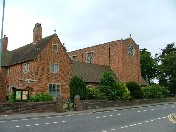 |
The story
of Sheringham Catholic church gathered strength in 1909
with the donation of more than £3,000 to purchase the
land around the chapel and build a large church. The
befactor was Catherine Deterding of Kelling Hall, wife of
the managing director of the Shell Oil company, although
her identity was not revealed until after her death in
1916. The commisioned architect was one of the greatest
of the day, Giles Gilbert Scott, busy on his greatest
triumph, the Anglican Cathedral at Liverpool.
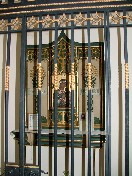 |
|
The
church was built in two stages, the northern
two-thirds opened by the Bishop of Northampton in
1910, and the southern extension completed in
1936. From outside, you can see the join clearly.
The vast red brick church towers over its
neighbours, recalling the presence of Scott's
Bankside power station in London, now Tate
Modern. The north end, liturgical east, has a
high rose window, the north and south sides being
flanked by sets of three vast Perpendicular-style
windows. You enter from the south-west
corner, through a porch and into a narthex. A
grilled area to the east contains a large framed
icon of the Blessed Virgin. This was once the
baptistry, but the font was moved into the body
of the church in response to the requirements of
Vatican II. And then you turn northwards, into
the church itself.
|
I had been
looking forward to the experience of stepping into St
Joseph for a number of years. I had first come across the
church in the early 1990s, in the days when I could still
be bothered to read Private Eye. It had been the
subject of ongoing criticism because of plans to reorder
the church in the light of Vatican II. This reordering
was happening quite late, because of the importance of
the architect involved and the fairly drastic action that
was about to take place. The problem was the marble high
altar, which was set against the wall. The sanctuary is
raised up, and there was not room to have a second altar
in front of it to allow for masses to be said facing the
people. However, it was not possible to move the altar
forward, because it was too long. In the end, it was
decided to shorten the altar by removing the reliquary
underneath it. This sounds drastic, but everyone I'd
spoken to who had visited the church since told me how
wonderful it was inside.
And so it
is. You step into dimness, and then the length of the
building opens up before you. The most striking thing is
the height and narrowness, which accentuate the arcades
which are also tall, the arches alternating in size.
There is a feel at once of both the Arts and Crafts
movement and the serious industrial Gothic for which
Scott was famous. The apparently medieval font just
inside the door is, in fact, a superb copy of the Little
Walsingham seven sacraments font.
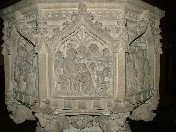 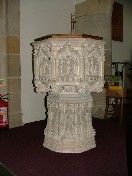 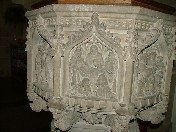
As you
wander towards the sanctuary, there is a growing feeling
of excitement. This church is an absolute treasure trove
of early 20th century art, particularly of the 1920s when
it was being enthusiastically furnished. This walk
culminates in the great altar piece of 1910. Seeing the
sanctuary now, it is hard to think that the reordering
was ever controversial. The reredos does look slightly
awkward, it is true, without an altar beneath it. Five of
the panels are copied from the Ranworth screen, the
addition being St Joseph in the bottom right corner, and
a seventh panel, Christ in Majesty, up at the top.
The
original church is now the Blessed Sacrament chapel, but
retains its first altar piece, a high gothic confection
with a statue of St Joseph holding the infant Christ,
flanked by St Cyril and St Methodius. This chapel has
good glass - on the north side are the Flight into Egypt,
and a curious deathbed scene depicting Christ and Mary
attending the bed of a person who must, I think, be
intended as the memorialised. Across the chapel is a
beautiful and interesting painted glass of St Mary of
Magdala. This must have come from elsewhere, because it
is older than the church, I think.
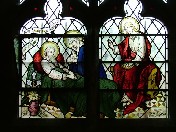 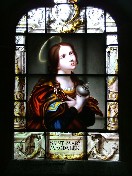 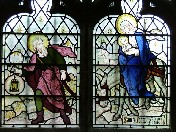
Stepping
back into the new church, the arcades disappear into
dimness thanks to the huge, dark expressionist window at
the south end. It does not let in much light. Halfway
along the west side is the lady chapel, and this is worth
more than a second glance. The altarpiece depicts Our
lady of Walsingham flanked by St Thomas More and St John
Fisher, but the real star of the piece is the relief of
the Annunciation on the front of the altar, which is
believed to be the work of the great Eric Gill.
If you are
an enthusiast of good early 20th century devotional art,
you will find much here to enjoy. Canon MacBride's book
records that many of the early furnishings were
commissioned from the Stuflesser workshop at Ortisei in
Italy. Theirs is the great rood above the entrance to the
sanctuary. Theirs also are the Stations of the Cross,
which spent the First World War in the hold of a German
freighter impounded at Genoa.
In short
then, this is a fascinating building, and not to be
missed by any Norfolk church explorer. I think that,
along with the Catholic church at Bungay in Suffolk, it
is one of the best of East Anglia's Catholic churches,
and one of the best pre-WWI 20th Century churches in
England. And, thanks to Scott, it remains Sheringham's
only listed building.
|
|
|

